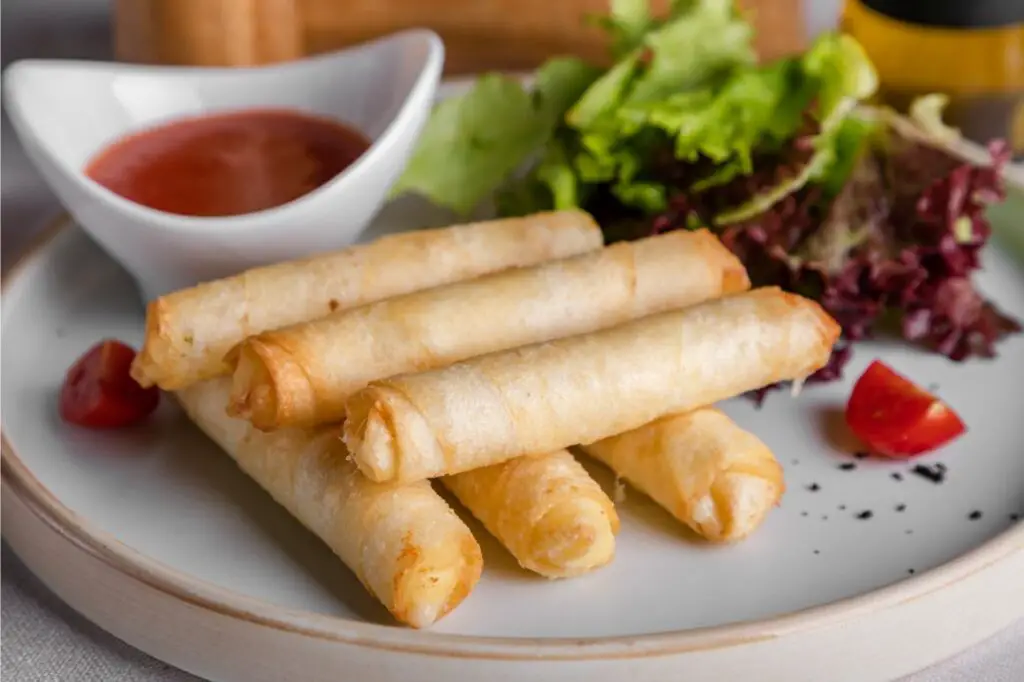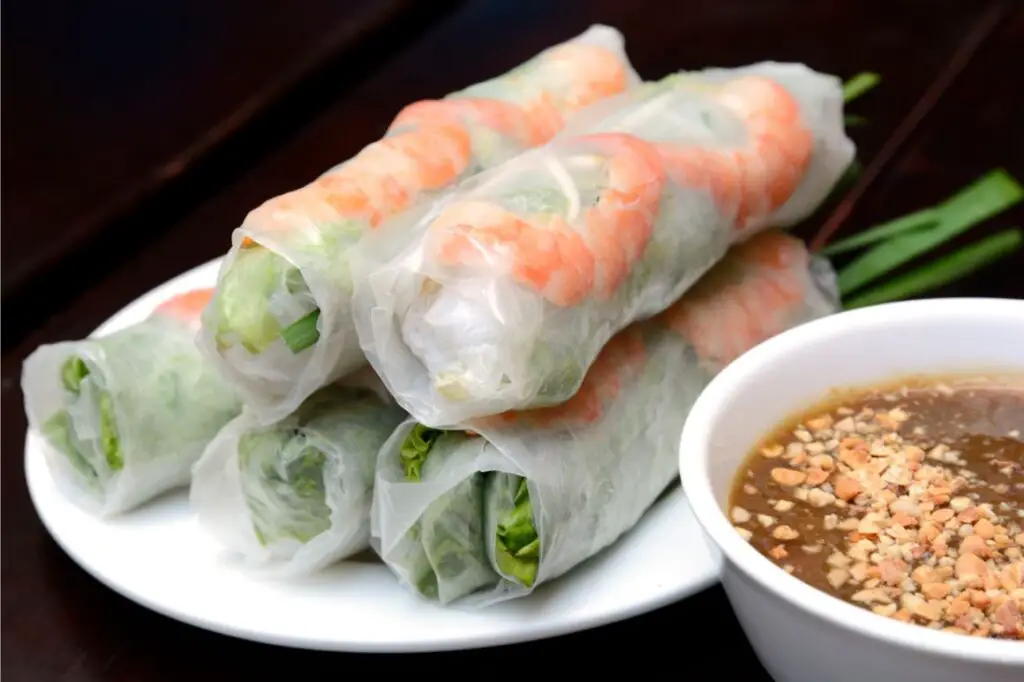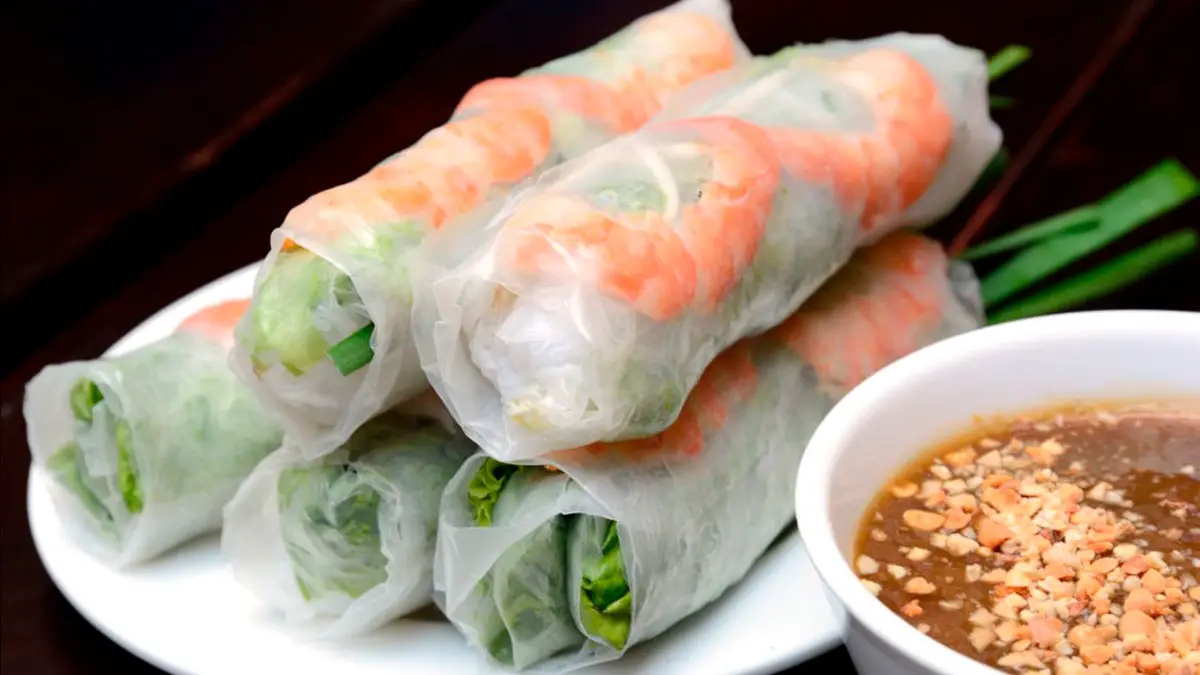This post may contain affiliate links. Please read my disclaimer.
If you love rolls, you’re in for a treat because today I’m going to talk about two types of rolls that people often mistake for each other: spring and summer! So whether you’re a fan of crispy, fried rolls or lighter, refreshing rolls, there’s something for everyone.
In this blog post, I’ll go over the differences between spring and summer rolls, including their ingredients, preparation, history, and health benefits.

What Are Spring Rolls?
Spring rolls are rolls with a mixture of vegetables and sometimes meat and then wrap them in thin, flour-based wrappers. They generally fry and serve them hot.
What Are Summer Rolls?
Summer rolls are made with thin rice paper wrappers and fill them with various raw vegetables and sometimes seafood or tofu. They serve them at room temperature and do not fry them.
History
People believe spring rolls originated in China and have since become a popular dish in many Asian countries. They served them as seasonal food during the spring, which is where they get their name. Vietnam is the origin of summer rolls, also known as “fresh spring rolls” or “salad rolls.”

Ingredients
Spring rolls are typically filled with a mixture of vegetables and sometimes meat, then wrapped in a thin, flour-based wrapper.
Common vegetables found in spring rolls include cabbage, carrots, and bean sprouts. Meat fillings can consist of shrimp, pork, or chicken.
On the other hand, summer rolls are filled with raw vegetables such as lettuce, cucumber, herbs, and sometimes seafood or tofu.
The wrapper used for summer rolls is made from rice paper, a thin and translucent paper made from rice flour and water.
Prep Work
Typically, people deep-fry spring rolls, giving them a crispy and golden brown exterior. They can serve them as is or with a dipping sauce such as sweet and sour sauce or soy sauce.
On the other hand, people do not fry summer rolls and assemble them by placing the filling ingredients on top of a rice paper wrapper and then rolling it up tightly.
They serve them at room temperature and often accompany them with a dipping sauce such as peanut or hoisin sauce.
Health Benefits
Spring rolls can be higher in calories and fat due to the deep-frying process, but they can still be a part of a healthy diet in moderation.
They can provide a good source of vegetables and protein if filled with various vegetables and a lean protein source.
On the other hand, summer rolls are a lower calorie and fat option because they are not fried and are made with raw vegetables.
They can provide a good source of vitamins and minerals from the vegetables and be a good option for those looking for a lighter, refreshing meal or snack!

Serving and Presentation
When it comes to serving and presentation, people can enjoy spring and summer rolls in various ways!
People typically serve spring rolls hot, and people can enjoy them as a snack or a larger meal. They can serve them on their own or with a dipping sauce.
Summer rolls are often served as an appetizer or as part of a larger meal, typically at room temperature.
People can present them whole or slice them in half for easier eating.
You May Also Like:
- How to Make Beef and Broccoli at Home (Better Than Takeout!)
- How to Make Ginger Scallion Sauce
- Easy Recipe for Hainanese Chicken Rice (in the Instant Pot!)
- Simple Chinese Tomato and Eggs
- How to Make Silky Chinese Steamed Eggs in the Instant Pot
Dipping Sauces for Spring Rolls vs. Summer Rolls
Spring rolls are typically served with dipping sauces such as sweet and sour sauce, soy sauce, or hoisin sauce.
On the other hand, summer rolls are often accompanied by a dipping sauce such as peanut sauce or hoisin sauce.
The sauce served with each roll type can vary depending on the region and personal preference. For example, some people may prefer to serve spring rolls with a spicy dipping sauce or a vinegar-based sauce, while others may choose a sweeter sauce.
Similarly, some people may enjoy serving summer rolls with a spicy dipping sauce or a citrus-based sauce, while others may prefer a more traditional peanut sauce.
Here is a simple chart showing a side-by-side comparison between spring rolls and summer rolls.
| Feature | Spring Roll | Summer Roll |
| Wrapper | Flour-based | Rice paper |
| Filling | Cooked or blanched vegetables and sometimes meat | Raw vegetables and sometimes seafood or tofu |
| Preparation | Deep-fried | Assembled by rolling up filling ingredients in rice paper wrapper |
| Serving temperature | Hot | Room temperature |
| Flavor | Savory | Light and refreshing |
| Texture | Crispy exterior, chewy interior | Soft and delicate |
| Origin | China | Vietnam |
You May Also Like:
- Easy Vietnamese Chicken Curry (Cà Ri Gà)
- The Most Flavorful Vietnamese Lemongrass Chicken Recipe You’ll Ever Try
- Easy Instant Pot Pho Ga (Chicken Pho)
- Warming Instant Pot Chao Ga (Vietnamese Chicken Congee)
- How to Make Vietnamese Red Rice
- How to Make Vietnamese Ga Roti the Easy Way (Vietnamese Rotisserie Chicken)
- Irresistible Instant Pot Bo Kho Recipe (Vietnamese Beef Stew)
Frequently Asked Questions
Why are summer rolls called summer rolls?
Summer rolls, also known as “fresh spring rolls” or “salad rolls,” are called summer rolls because they are typically served cold and are a refreshing option for summer months.
The rice paper wrapper and raw vegetables used in summer rolls give them a lighter and cooler taste than the fried and warm spring rolls.
Summer rolls are popular for summertime meals or refreshing appetizers on a hot day. They can be enjoyed at any time of the year and are not limited to the summer months.
What is the difference between a spring roll and an egg roll?
One of the primary differences between spring rolls and egg rolls is the type of wrapper used. Spring rolls are typically wrapped in a thin, flour-based wrapper, while egg rolls are wrapped in a thicker, doughier wrapper made with wheat flour and eggs.
Another difference is the filling. Spring rolls are typically filled with a mixture of vegetables and sometimes meat, while egg rolls are filled with a mix of chopped vegetables and sometimes meat or seafood. The filling for egg rolls is usually slightly heavier and more savory than spring rolls.
The preparation method is also different. Spring rolls are usually deep-fried, while egg rolls are pan-fried or deep-fried. This results in a crispy and golden brown exterior for both types of rolls, but the wrapper’s texture is generally denser and chewier for egg rolls due to the egg and wheat flour in the wrapper.
Final Thoughts
Spring rolls and summer rolls may seem similar at first glance, but they are actually quite different in terms of their ingredients, preparation, and origin!
Spring rolls are fried and filled with a mixture of vegetables and sometimes meat, while summer rolls are made with raw vegetables and a rice paper wrapper and are not fried.
Both can be part of a healthy diet in moderation, but summer rolls may be a lower calorie and fat option due to their raw vegetable filling and lack of frying.
When it comes to serving and presentation, both can be enjoyed in various ways and served as snacks or part of a larger meal.
I hope this blog post has helped clarify the differences between spring and summer rolls!
Which type of roll do you prefer: spring rolls or summer rolls? Have you ever tried making either type at home? Please leave me a comment and let me know below! I’d love to hear from you.
TIP: Pin this image below by hovering over it to save it to your Pinterest account and refer back to it later.


